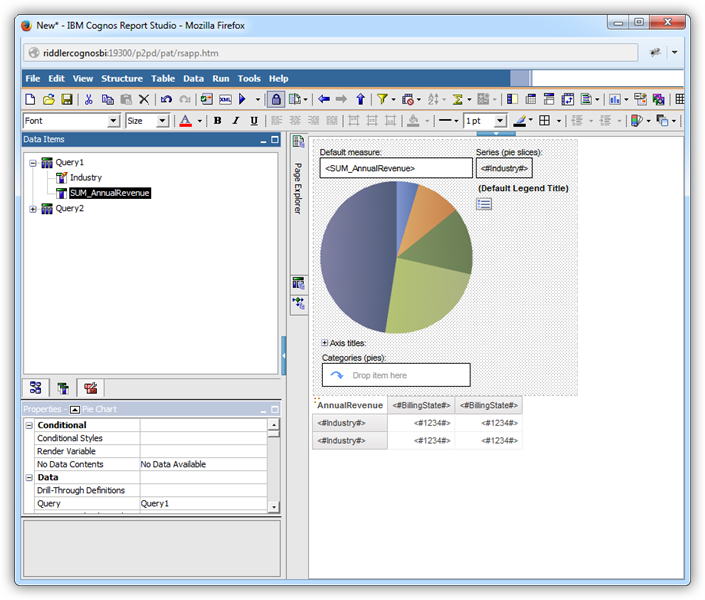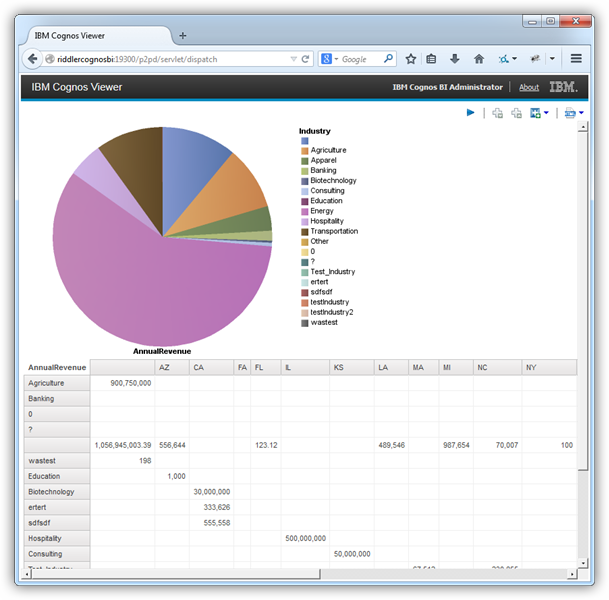Discover how a bimodal integration strategy can address the major data management challenges facing your organization today.
Get the Report →Create Data Visualizations in Cognos BI with Airtable Data
Access Airtable data as an ODBC data source in Cognos Business Intelligence and create data visualizations in Cognos Report Studio.
You can use the CData ODBC driver for Airtable to integrate Airtable data with the drag-and-drop style of Cognos Report Studio. This article describes both a graphical approach to create data visualizations, with no SQL required, as well as how to execute any SQL query supported by Airtable.
Configure and Publish the Data Source
If you have not already, first specify connection properties in an ODBC DSN (data source name). This is the last step of the driver installation. You can use the Microsoft ODBC Data Source Administrator to create and configure ODBC DSNs.
APIKey, BaseId and TableNames parameters are required to connect to Airtable. ViewNames is an optional parameter where views of the tables may be specified.
- APIKey : API Key of your account. To obtain this value, after logging in go to Account. In API section click Generate API key.
- BaseId : Id of your base. To obtain this value, it is in the same section as the APIKey. Click on Airtable API, or navigate to https://airtable.com/api and select a base. In the introduction section you can find "The ID of this base is appxxN2ftedc0nEG7."
- TableNames : A comma separated list of table names for the selected base. These are the same names of tables as found in the UI.
- ViewNames : A comma separated list of views in the format of (table.view) names. These are the same names of the views as found in the UI.
When you configure the DSN, you may also want to set the Max Rows connection property. This will limit the number of rows returned, which is especially helpful for improving performance when designing reports and visualizations.
If you are running Cognos from a 64-bit machine and want to modify the DSN or create other Airtable DSNs, you must use a system DSN. You will also need to open the 32-bit ODBC Data Source Administrator. You can open it with the following command:
C:\Windows\sysWOW64\odbcad32.exe
After creating a DSN, you can then publish the data source:
- Open Cognos Administration and click Data Source Connections to add a new data source:
-
Select the ODBC option and enter the DSN, CData Airtable Sys, and a user-friendly name.
- Click Retrieve Objects and choose the CData Airtable database object.
![The DSN used to add the data source. (Salesforce is shown.)]()
Add Data Visualizations to a Report
You can now create reports on Airtable data in Cognos Report Studio by dragging and dropping table columns from the Source Explorer onto report objects. The sections below show how to create a simple report with a chart that shows up-to-date data.
As you build the report, Cognos Report Studio will generate SQL queries and rely on the driver to execute them. The driver will convert queries into requests to the Airtable API. To execute queries to the live Airtable data, the driver depends on the capabilities of the underlying API.
Create a Chart Based on an Aggregate
You can populate almost any report object in Cognos with Airtable data by simply dragging and dropping columns from the Source Explorer onto the dimensions of the object. The column in the Series dimension of the chart is automatically grouped.
Additionally, Cognos sets a logical default aggregate function for the measure dimension based on the data type. For this example, override the default by clicking the Column1 column in the Data Items tab and set the Aggregate Function property to Not Applicable. The Rollup Aggregate Function property must be set to Automatic.

Convert a Query Object to SQL
When you know the query you need, or if you want to adjust the generated query, convert a query object into an SQL statement. After a query has been converted to SQL, the UI controls are not available for the query object. Follow the procedure below to populate a chart with user-defined SQL.
Cognos will rely on the driver to execute the user-defined query. Using the driver's SQL engine ensures that queries will always return up-to-date results, as there is no cached copy of the data.
- Hover over the Query Explorer and click the Queries folder to display the query objects in your report.
-
If you want to edit the autogenerated query, click the button in the Generated SQL property for the query object. In the resulting dialog, click Convert.
If you want to enter a new SQL statement, drop an SQL object in-line with the query object.
- Modify the properties for the SQL object: Select the Airtable data source in the SQL properties and set the SQL Syntax property to Native.
Click the button in the SQL property and enter the SQL query in the resulting dialog. This example uses the query below:
SELECT Id, Column1 FROM SampleTable_1 WHERE Column2 = 'SomeValue'Modify the properties for the query object: Set the Processing property to "Limited Local". This value is required to convert a query object to SQL.
![A query object created from an SQL statement.]()
Fill a Chart with the Results of a Query
You can now access the results of the SQL query as objects in the Data Items tab. Follow the procedure below to create a chart with the results; for example, the Column1 for each Id from the SampleTable_1 table.
- Return to the page by hovering over the Page Explorer and then clicking the page object.
- Drag a pie chart from the toolbox onto the workspace.
- In the properties for the chart, set the Query property to the name of the query you created above.
- Click the Data Items tab and drag columns onto the x- and y-axes. In this example, drag the Id column to the Series (pie slices) box and the Column1 column to the Default Measure box.
-
Modify the default properties for the Default Measure (the Column1 values): In the Aggregate Function box, select the Total option.

Run the report to add the results of the query.









